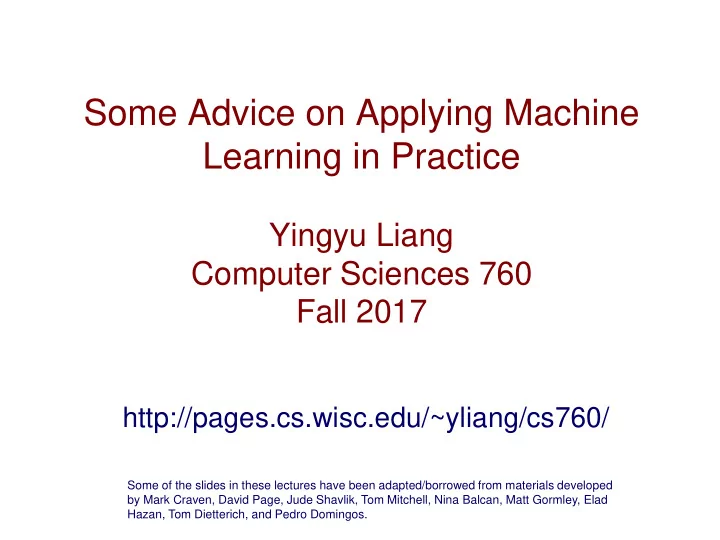

Some Advice on Applying Machine Learning in Practice Yingyu Liang Computer Sciences 760 Fall 2017 http://pages.cs.wisc.edu/~yliang/cs760/ Some of the slides in these lectures have been adapted/borrowed from materials developed by Mark Craven, David Page, Jude Shavlik, Tom Mitchell, Nina Balcan, Matt Gormley, Elad Hazan, Tom Dietterich, and Pedro Domingos.
It’s generalization that counts • the fundamental goal of machine learning is generalize beyond the instances in the training set • you should rigorously measure generalization • use a completely held-aside test set • or use cross validation
It’s generalization that counts • but be careful not to let any information from test sets leak into training • be careful about overfitting a data set, even when using cross validation
It’s generalization that counts • compare multiple learning approaches • there is no single best approach
Data alone is not enough • learning algorithms require inductive biases • smoothness • similar instances having similar classes • limited dependencies • limited complexity
Data alone is not enough • when choosing a representation, consider what kinds of background knowledge are easily expressed in it • what makes instances similar → kernels • dependencies → graphical models • logical rules → inductive logic programming • etc.
The importance of representation • each domino covers two squares • can you cover the board with dominoes? • the solution is more apparent when we change the representation
Feature engineering is key • typically the most important factor in a learning task is the feature representation • many independent features that correlate with class → learning is easy • class is a complex function of features → learning is hard • try to craft features that make apparent what might be most important for the task
Learn many models, not just one • winning team and runner-up were both formed by merging multiple teams • winning systems were ensembles with > 100 models • combination of the the two winning systems was even more accurate
Learn many models, not just one • the lesson is more general than the Netflix prize • ensembles very often improve the accuracy of individual models
We may care more about the model than actually making predictions • two principal reasons for using machine learning 1. to make predictions about test instances 2. to gain insight into the problem domain • for the former, a complicated black box may be okay • for the latter, we want our models to be comprehensible to some degree
We may care more about the model than actually making predictions • example: inferring Bayesian networks to represent intracellular networks [Sachs et al., Science 2005]
In many cases, we care about both • example: predicting post-hospitalization VTE risk given patient histories [Kawaler et al., AMIA 2012] • want to identify patients at risk with high accuracy • want to identify previously unrecognized risk factors
Theoretical guarantees are not what they seem • PAC bounds are extremely loose • asymptotic results tell us what happens when given infinite amounts of data – we don’t usually have this • learning theory results are generally • useful for understanding learning, driving algorithm design • not a criterion for practical decisions
Do assumptions of algorithm hold? • be sure to check the assumptions made by an approach/methodology against your problem domain • Are the instances i.i.d. or should we take into account dependencies among them? • When we divide a data set into training/test sets, is the division representative of how the learner will be used in practice? • etc. • questioning the assumptions of standard approaches sometimes results in new paradigms • active learning • multiple-instance learning • etc.
Compare against reasonable baselines • Empirically determine whether fancy ML methods have value by comparing against • simple predictors (e.g. tomorrow’s weather will be the same as today’s) • standard predictors in use • individual features
Recommend
More recommend